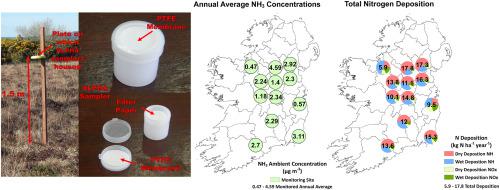Atmospheric Environment ( IF 5 ) Pub Date : 2021-07-09 , DOI: 10.1016/j.atmosenv.2021.118611 David B. Kelleghan 1 , Enda T. Hayes 2 , Mark Everard 3 , Padraig Keating 1 , Anna Lesniak-Podsiadlo 1 , Thomas P. Curran 1

|
With growing global demand for food, the agriculture sector worldwide is under pressure to intensify and expand, risking acceleration of existing negative biodiversity impacts. Agriculture is the dominant source of ammonia (NH3) emissions, which can impact biodiversity directly through dry deposition as NH3 and by wet deposition following conversion to ammonium (NH4) in the atmosphere. Nitrogen deposition is one of the leading causes of global decline in biodiversity alongside changing land use and climate. Natura 2000 sites which are intended to protect important habitats and species across Europe, require strict levels of protection to ensure designated features achieve favourable conservation status. Many of these sites are nitrogen-limited, and/or contain sensitive species such as lichens or mosses. This project carried out ambient NH3 monitoring on selected Irish Natura 2000 sites, in order to establish potential impacts from agricultural NH3. Monitoring on twelve Natura 2000 sites observed concentrations ranging from 0.47 to 4.59 μg NH3 m−3, from which dry deposition was calculated to be 1.22–11.92 kg N ha−1 yr−1. European Monitoring and Evaluation Programme (EMEP) was used to quantify wet deposited NH4 and nitrogen oxides (NOx), in addition to dry deposited NOx on monitored sites. Estimated total nitrogen deposition ranged between 5.93 and 17.78 kg N ha−1 yr−1. On average across all monitored sites, deposition was comprised of 50.4%, 31.7%, 7.5%, and 10.3% dry NH3, wet NH4, dry NOx and wet NOx respectively. Implications for Irish agriculture are discussed in the light of both this monitoring and the European Commission Dutch Nitrogen Case (C 293/17 & C 294/17), highlighting a number of recommendations to aid compliance with the EU Habitats Directive (92/43/EEC).
中文翻译:

爱尔兰 Natura 2000 站点上的大气氨和氮沉积:对爱尔兰农业的影响
随着全球对粮食的需求不断增长,世界范围内的农业部门面临着加强和扩大的压力,这有可能加速现有的对生物多样性的负面影响。农业是氨 (NH 3 ) 排放的主要来源,氨 (NH 3 ) 排放可直接通过干沉降作为 NH 3以及转化为铵 (NH 4) 在大气中。随着土地利用和气候的变化,氮沉降是全球生物多样性减少的主要原因之一。Natura 2000 遗址旨在保护整个欧洲的重要栖息地和物种,需要严格的保护水平,以确保指定的特征达到有利的保护状态。许多这些地点都限制氮,和/或包含敏感物种,如地衣或苔藓。该项目对选定的爱尔兰 Natura 2000 站点进行了环境 NH 3监测,以确定农业 NH 3 的潜在影响。对 12 个 Natura 2000 站点的监测观察到的浓度范围为 0.47 至 4.59 μg NH 3 m -3,从中计算出干沉降为 1.22–11.92 kg N ha -1 yr -1。欧洲监测和评估计划 (EMEP) 用于量化湿沉积的 NH 4和氮氧化物 (NOx),以及监测地点的干沉积 NOx。估计的总氮沉积量介于 5.93 和 17.78 kg N ha -1 yr -1 之间。平均而言,所有监测地点的沉积物包括 50.4%、31.7%、7.5% 和 10.3% 的干 NH 3、湿 NH 4,分别为干 NOx 和湿 NOx。根据该监测和欧盟委员会荷兰氮案例(C 293/17 和 C 294/17)讨论了对爱尔兰农业的影响,强调了一些有助于遵守欧盟栖息地指令(92/43/欧洲经济共同体)。


























 京公网安备 11010802027423号
京公网安备 11010802027423号